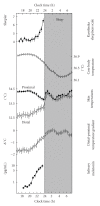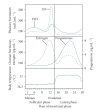Sleep, Hormones, and Circadian Rhythms throughout the Menstrual Cycle in Healthy Women and Women with Premenstrual Dysphoric Disorder
- PMID: 20145718
- PMCID: PMC2817387
- DOI: 10.1155/2010/259345
Sleep, Hormones, and Circadian Rhythms throughout the Menstrual Cycle in Healthy Women and Women with Premenstrual Dysphoric Disorder
Abstract
A relationship exists between the sleep-wake cycle and hormone secretion, which, in women, is further modulated by the menstrual cycle. This interaction can influence sleep across the menstrual cycle in healthy women and in women with premenstrual dysphoric disorder (PMDD), who experience specific alterations of circadian rhythms during their symptomatic luteal phase along with sleep disturbances during this time. This review will address the variation of sleep at different menstrual phases in healthy and PMDD women, as well as changes in circadian rhythms, with an emphasis on their relationship with female sex hormones. It will conclude with a brief discussion on nonpharmacological treatments of PMDD which use chronotherapeutic methods to realign circadian rhythms as a means of improving sleep and mood in these women.
Figures




Similar articles
-
Investigating biological rhythms disruptions across the menstrual cycle in women with comorbid bipolar disorder and premenstrual dysphoric disorder.Arch Womens Ment Health. 2022 Apr;25(2):345-353. doi: 10.1007/s00737-022-01220-0. Epub 2022 Feb 28. Arch Womens Ment Health. 2022. PMID: 35226173
-
Pilot investigation of the circadian plasma melatonin rhythm across the menstrual cycle in a small group of women with premenstrual dysphoric disorder.PLoS One. 2012;7(12):e51929. doi: 10.1371/journal.pone.0051929. Epub 2012 Dec 19. PLoS One. 2012. PMID: 23284821 Free PMC article.
-
Nocturnal polysomnographic sleep across the menstrual cycle in premenstrual dysphoric disorder.Sleep Med. 2012 Sep;13(8):1071-8. doi: 10.1016/j.sleep.2012.05.012. Epub 2012 Jun 30. Sleep Med. 2012. PMID: 22749440
-
The impact of pharmacotherapy for premenstrual dysphoric disorder on sleep.Sleep Med Rev. 2025 Apr;80:102069. doi: 10.1016/j.smrv.2025.102069. Epub 2025 Feb 7. Sleep Med Rev. 2025. PMID: 39952094 Review.
-
Circadian rhythms, sleep, and the menstrual cycle.Sleep Med. 2007 Sep;8(6):613-22. doi: 10.1016/j.sleep.2006.09.011. Epub 2007 Mar 26. Sleep Med. 2007. PMID: 17383933 Review.
Cited by
-
Hemodynamic and psychological responses to laboratory stressors in women: assessing the roles of menstrual cycle phase, premenstrual symptomatology, and sleep characteristics.Int J Psychophysiol. 2012 Dec;86(3):283-90. doi: 10.1016/j.ijpsycho.2012.10.009. Epub 2012 Oct 23. Int J Psychophysiol. 2012. PMID: 23092740 Free PMC article.
-
Biological rhythms in premenstrual syndrome and premenstrual dysphoric disorder: a systematic review.BMC Womens Health. 2024 Oct 7;24(1):551. doi: 10.1186/s12905-024-03395-3. BMC Womens Health. 2024. PMID: 39375682 Free PMC article.
-
Role of Ovarian Hormones in the Modulation of Sleep in Females Across the Adult Lifespan.Endocrinology. 2020 Sep 1;161(9):bqaa128. doi: 10.1210/endocr/bqaa128. Endocrinology. 2020. PMID: 32735650 Free PMC article. Review.
-
Sleep Disturbances Across a Woman's Lifespan: What Is the Role of Reproductive Hormones?J Endocr Soc. 2023 Mar 15;7(5):bvad036. doi: 10.1210/jendso/bvad036. eCollection 2023 Mar 6. J Endocr Soc. 2023. PMID: 37091307 Free PMC article. Review.
-
The Menstrual Cycle and Sleep.Sleep Med Clin. 2023 Dec;18(4):399-413. doi: 10.1016/j.jsmc.2023.06.003. Epub 2023 Jul 16. Sleep Med Clin. 2023. PMID: 38501513 Free PMC article. Review.
References
-
- Soares CN. Insomnia in women: an overlooked epidemic? Archives of Women’s Mental Health. 2005;8(4):205–213. - PubMed
-
- Manber R, Bootzin RR. Sleep and the menstrual cycle. Health Psychology. 1997;16(3):209–214. - PubMed
-
- Hurt SW, Schnurr PP, Severino SK, et al. Late luteal phase dysphoric disorder in 670 women evaluated for premenstrual complaints. American Journal of Psychiatry. 1992;149(4):525–530. - PubMed
-
- Meerlo P, Sgoifo A, Suchecki D. Restricted and disrupted sleep: effects on autonomic function, neuroendocrine stress systems and stress responsivity. Sleep Medicine Reviews. 2008;12(3):197–210. - PubMed
LinkOut - more resources
Full Text Sources
Other Literature Sources

